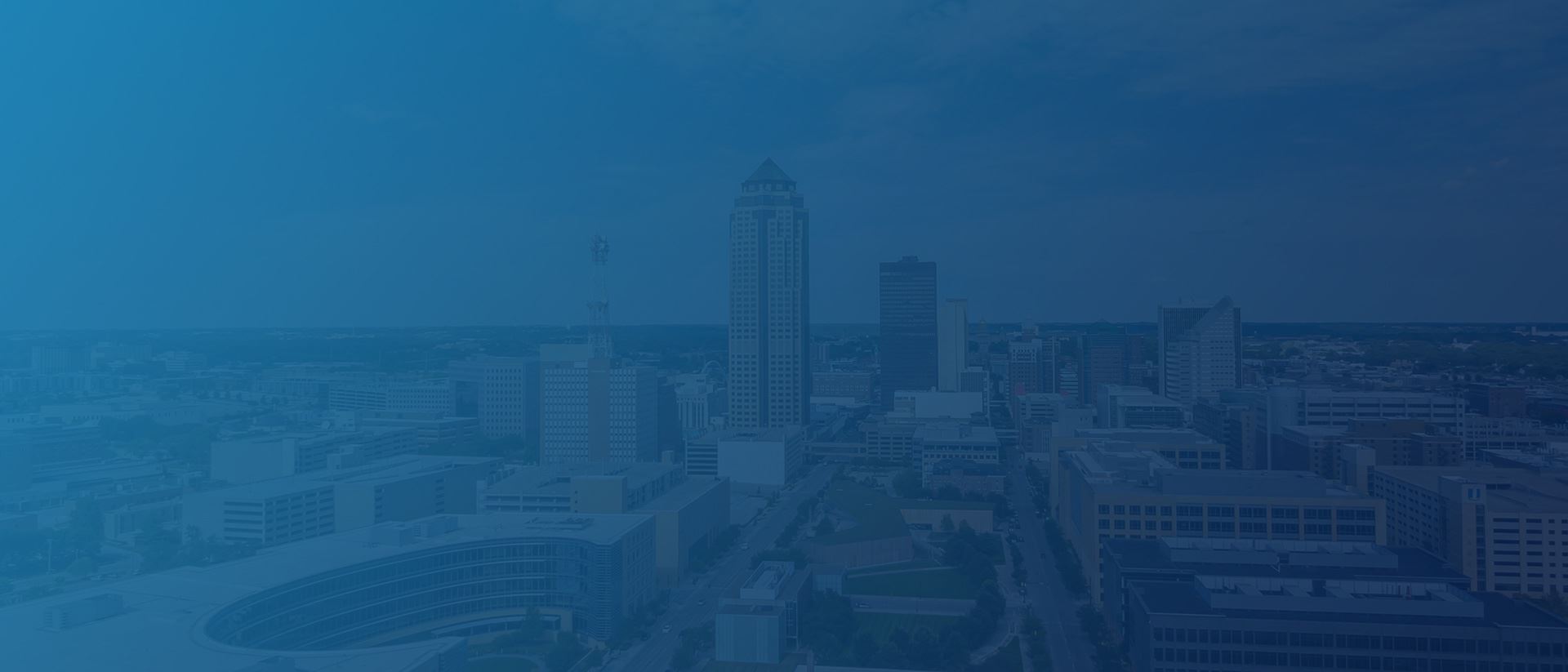
Des Moines Construction Accident Attorneys
Helping Workers Obtain Compensation for Construction-Related Injuries
Construction is an inherently dangerous occupation. However, employers can take essential steps to protect workers and bring injury incidents down to zero. Unfortunately, builders often fail to implement simple measures.
If you have been injured on the jobsite, you are likely eligible for Iowa workers’ compensation benefits. You may also have a valid civil claim against manufacturers, property owners and co-workers who acted with gross negligence.
The Hope Law Firm, PLC can guide you through the process of obtaining compensation for the injuries you sustained at your workplace. If you lost a family member, we can pursue justice against the negligent person or corporation that caused the catastrophic death.
Learn more about how our Des Moines construction accident attorneys can help you by calling (515) 298-5056 or contacting us online today!
The Fatal Four
The Occupational Safety & Health Administration (OSHA) reports that more than one-fifth of all job-related deaths in the private sector in 2013 occurred in the construction industry, accounting for 796 fatalities. OSHA has dubbed the primary causes of construction job deaths “the Fatal Four,” which are:
- Falls (294 deaths in 2013) — Falls are the leading cause of death in the construction industry. They can occur from elevated work surfaces, such as roofs, scaffolds, ladders, or edges of buildings. Inadequate fall protection measures, improper use of fall protection equipment, and lack of proper training contribute to fall-related accidents.
- Struck by an object (82 deaths) — Accidents where workers are struck by objects rank second in the Fatal Four. This includes incidents where construction materials, tools, or equipment fall or are propelled and strike a worker. Common scenarios include objects falling from heights, equipment malfunctions, or improper storage and handling of materials.
- Electrocutions (71 deaths) — Electrocutions occur when workers come into contact with live electrical sources. This could happen during the installation, maintenance, or repair of electrical systems. Factors contributing to electrocution incidents include working near power lines without adequate clearance, faulty equipment, and lack of proper training on electrical safety.
- Caught in or between objects (21 deaths) — This category involves accidents where workers are caught, crushed, or compressed between two objects or surfaces. Examples include being caught in machinery, pinned between vehicles or equipment, or trapped in collapsing structures. Inadequate guarding, lack of proper lockout/tagout procedures, and unsafe trenching and excavation practices can contribute to these incidents.
Just by eliminating the risks for a fatal four accident, contractors can prevent almost 60 percent of jobsite fatalities.
What to do After a Construction Accident
Experiencing a construction accident can be overwhelming, but it's crucial to understand your legal rights and options for recovery. At Hope Law Firm, we are dedicated to ensuring that you are fully informed about your entitlements. Many workers may not realize that they could be eligible for compensation beyond workers' compensation benefits. If you’ve sustained injuries due to negligence, unsafe working conditions, or faulty equipment, you may have grounds for a personal injury claim.
Here’s what you should consider in the aftermath of a construction accident:
- Document Everything: Keep detailed records of the accident, including photographs, witness contact information, and medical documentation.
- Report the Incident: Ensure that the accident is reported to your supervisor or site manager as soon as possible to solidify your claim.
- Seek Medical Attention: Prioritize your health by consulting a medical professional for injuries, even if they seem minor.
- Consult a Legal Expert: Navigating the complexities of construction injury law can be daunting. Our experienced attorneys can guide you through the process, ensuring you receive the compensation you deserve.
Don’t let the challenges of a construction accident weigh you down. At Hope Law Firm, we are here to support you every step of the way. Let us help you understand your rights and pursue a path to recovery.
Understanding Your Rights After a Construction Accident
Having a clear understanding of your legal rights following a construction accident is crucial for ensuring that you receive the compensation you deserve. It's important to remember that various laws and regulations apply to workplace injuries, particularly in the construction industry. At Hope Law Firm, we are dedicated to guiding you through the complexities of personal injury law, empowering you to make informed decisions about your case.
Here are some key rights you should be aware of:
- Workers' Compensation: If injured on the job, you may be entitled to workers' compensation benefits to cover medical expenses and lost wages, regardless of fault.
- Third-Party Claims: If another party (like equipment manufacturers or subcontractors) played a role in your injury, you could pursue a third-party claim for additional compensation.
- Right to a Safe Workplace: Employers are legally obligated to provide a safe working environment. If negligence led to unsafe conditions, you may have a case against your employer.
- Legal Representation: You have the right to seek legal advice. An experienced attorney can help you navigate the complexities of your case and advocate on your behalf.
Our team at Hope Law Firm is here to provide you with the knowledge and support you need during this difficult time. We believe that every injured worker deserves strong representation, and we are committed to fighting for your rights. Contact us today to schedule a free consultation and let us help you pursue the justice and compensation you deserve.
Common Construction Site Risks
Your employer and the jobsite property owner owe you a duty to follow Iowa and federal laws regarding safety on the construction site. However, their negligence can put you at risk of:
- Explosions and fires — You risk burn injury due to explosion or fire, especially on sites where volatile materials are mishandled or improperly stored.
- Crane accidents — A crane that is not adequately secured or that has defective parts can collapse, injuring the crane operator and the workers below.
- Falls from height — By forgoing such basic safety devices as guardrails and personal fall-arrest systems, your employer can unnecessarily subject you to serious fall risks.
- Tools falling from above — Insufficient netting and scaffolding put you at risk of head injuries from tools that fall.
- Defective ladder — A broken or defectively designed ladder leaves you vulnerable to falls from substantial heights.
- Heavy equipment accident — A reckless driver of a backhoe, dump truck, excavator or other heavy machinery may run over you at the worksite.
- Speeding drivers — Roadside construction crews are at constant risk of being hit by speeding and distracted motorists.
In addition, manufacturers of construction equipment are obligated to follow basic standards for producing safe construction tools and machinery.
Learn more about how our Des Moines construction accident attorneys can help you by calling (515) 298-5056 or contacting us online today!
Compensation After a Construction Accident
Workers' compensation in Iowa is a system designed to provide benefits to employees who have suffered work-related injuries or illnesses. Iowa's workers' compensation system operates on a no-fault basis. This means that injured workers are eligible for benefits regardless of who was at fault for the accident or injury, as long as it was not intentionally self-inflicted.
Workers' compensation in Iowa provides several types of benefits to eligible employees. These benefits may include:
- Medical Benefits: Workers' compensation covers necessary medical treatment related to the work injury or illness. This includes doctor visits, hospitalization, medication, physical therapy, and rehabilitation services.
- Temporary Total Disability (TTD) Benefits: If the injury or illness prevents the employee from working for a temporary period, they may be entitled to TTD benefits. These benefits generally provide a percentage of the worker's average weekly wage during the recovery period.
- Permanent Partial Disability (PPD) Benefits: If the work-related injury or illness results in a permanent impairment, but the employee can still work in some capacity, they may be eligible for PPD benefits. These benefits are based on the extent of the impairment and the employee's wage loss.
- Vocational Rehabilitation: In cases where the worker is unable to return to their previous job due to the injury or illness, vocational rehabilitation services may be provided to assist them in finding suitable employment.
However, if the accident is caused by the negligence of a third party, the injured party may have grounds for a personal injury lawsuit. In a personal injury claim, the injured party may seek additional compensation for pain and suffering, and emotional distress, on top of damages for medical expenses and lost wages.
The following are several potential third parties who can be held liable for a construction accident:
- Subcontractor Negligence: Subcontractors on a construction site are often responsible for specific tasks or areas. If a subcontractor fails to adhere to safety regulations, neglects proper training for their workers, or creates hazardous conditions that lead to an accident, they may be held liable for any resulting injuries.
- Equipment Manufacturer Negligence: If the accident is caused by a defect in construction equipment or tools, the manufacturer may be held responsible. This could include issues like design flaws, manufacturing defects, or inadequate warnings about potential dangers associated with the use of the equipment.
- Property Owner Negligence: Property owners have a duty to maintain a safe environment for workers on their premises. Negligence on the part of a property owner might involve failure to address known hazards, inadequate warning signs, or failure to comply with safety regulations, leading to accidents and injuries.
- General Contractor Negligence: The general contractor overseeing the construction project bears a significant responsibility for overall site safety. If the general contractor fails to implement and enforce proper safety protocols, coordinate effectively among subcontractors, or address known hazards, they may be held liable for injuries suffered by workers.
- Architect or Engineer Negligence: In some cases, design professionals, such as architects or engineers, may be held liable for injuries resulting from design flaws or inadequate planning. If the design of a structure or component is inherently unsafe and leads to an accident, the design professional may be a potential defendant in a personal injury lawsuit.
- Proving Third-Party Negligence: Establishing third-party negligence involves showing that the responsible party had a duty of care, breached that duty through negligent actions or omissions, and that this breach directly caused the injury. This often requires a thorough investigation, gathering evidence, and consulting with experts to establish the link between negligence and the accident.
- Potential Compensation: In a personal injury lawsuit based on third-party negligence, the injured party may seek compensation for various damages, including medical expenses, lost wages, pain and suffering, emotional distress, and, in certain cases, punitive damages to punish the negligent party for particularly reckless behavior.


Our Recognitions
Get the Compensation You Deserve for Your Construction-Related Injuries
The Hope Law Firm, PLC offers a free case assessment to determine whether you have a case for damages arising from a Des Moines construction accident. We do not charge you attorney fees unless we win your case, and we can work out a payment plan to help you through this difficult time.
Call our Des Moines construction accident lawyers at (515) 298-5056or contact us online to schedule an appointment today.

Why Hope Law Firm?
See How We Stand Apart
-
Thousands of cases successfully handled for our clients.
-
No fee until we win & flexible hours to meet your needs.
-
We treat you with compassion, honesty, dignity and respect.
-
We take an aggressive approach & have a proven track record.













